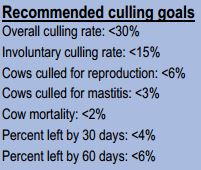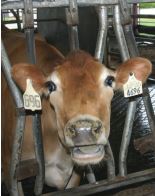



What Story Does Your Culling Pattern Tell You?
If you are culling over a third of your herd then its too much, Virginia farmers are hearing as part of a way to boost profits.Culling is a regular part of dairy herd management; cows leave the herd for a variety of reasons on a routine basis.
In fact, culling may be so commonplace that one forgets to take time to discover what culling patterns can reveal about management, writes an extension officer at Virginia Cooperative.
*
"The overall goal of culling is to improve profitability of the herd"
The biggest reasons for culling and the timing of culling relative to days in milk can offer hints about issues in the herd that could include transition cow management, mastitis, and reproduction, says Dave Winston.
The ability to conduct a reasonable analysis of culling begins with good record keeping. Accurate reporting of when and specifically why an animal left the herd is key. DHIA herds can report culling information at each test day.
Those enrolled in PCDART can make entries at any time; these herds can also submit a primary and secondary reason for culling.

Typical reasons for culling reported on DHIA are dairy (sold to another producer), low production, reproduction, mastitis, udder, feet and legs, injury, disease, and death.
Culling can be divided into two categories: voluntary and involuntary.
Voluntary Culling
Voluntary culling is desirable culling. It is an opportunity to generate additional income through dairy sales and/ or to improve the quality of the herd by eliminating the lowest producers. Cows sold for dairy purposes are expected to generate more income that those sold for beef.
Involuntary Culling
Involuntary culling is undesirable; it is culling resulting from some sort of problem with the cow including that she will not breed, has mastitis, or gets injured. Death is obviously the least desirable cull since there is no salvage value.
In order to sell more animals for voluntary reasons, one must keep involuntary culling rates low. One cannot simply solve all herd problems strictly through culling without addressing the underlying cause. For example, if a herd has a mastitis problem, culling will not solve the issue if the underlying cause for mastitis has not been addressed—like poor milking procedures or an unclean environment.
What to Recommend?
The optimal level of culling may differ from herd to herd. Milk, feed, and cull cow prices influence this optimal level as well as the herd’s plans for herd size maintenance or growth.

It is recommended that herds with plans of maintaining herd size have an overall culling rate of 30 per cent or less. Herds in expansion mode that are attempting to increase herd size from within would be expected to have a lower culling rate.
The best time for a cow to be culled from the herd is later in lactation. Culling in early lactation is costly because one fails to realize the cow’s peak milk potential. It is recommended that less that 4 per cent of cows be culled in the first 30 days of lactation and less that 6 per cent in the first 60 days.
Dairy Records Management Systems developed an excellent tool to help producers analyze culling patterns in the herd. The DHI-232 Survival Analysis report may be selected by producers who want to know more about their culling than just the number of animals that left the herd in the past 12 months.
This report contains an initial breakdown of culling by lactation, month of calving, and days in milk. It also offers a survival curve by lactation that graphically depicts when during the lactation cows are leaving the herd.
The last page of the report contains a summary of the reasons cows left herd by days since fresh and lactation. If too many cows are leaving in early lactation, this report can call attention to the primary reasons. The overall goal of culling is to improve profitability of the herd. Paying attention to the reasons for and timing of culling can improve overall herd management.



